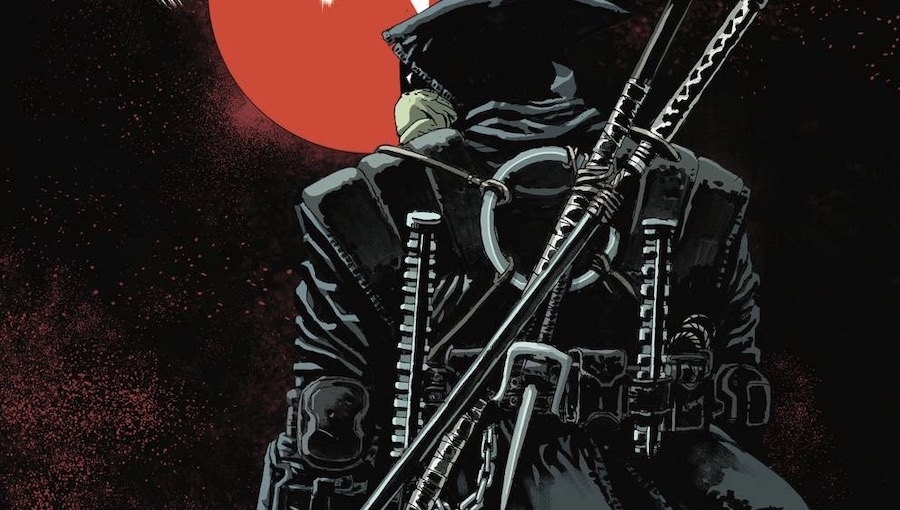I started scrolling through the PDF reviewer’s copy of The Last Ronin, the new Teenage Mutant Ninja Turtles tale from the dynamic duo of my youth, Eastman and Laird. “These are amazing alternate covers,” I thought to myself. I continued to scroll, “Oh, wow, more!”… I continued to scroll… and scroll… and scroll… just as Pee Wee Herman kept knitting and knitting and knitting. There are 71 retail covers for The Last Ronan. SEVENTY-ONE! All beautiful. All showing a scarred, broken, and aged mutant turtle armed to the hilt with all four of the brothers’ weapons – katana, nunchucks, staff, and sai – and wearing a black mask around his eyes.
When I recently read about this new series, sold as an adult take on the Turtles, my interest was piqued. It’s true that the original comic book was pretty bloody and violent and written for a kid my age and became kid friendly later. My life as a kid and teenager was chalk-full of nothing but TMNT, though I haven’t read a TMNT comic since issue 50 of the previous series when Donatello was “killed.” I cried real tears, only to find out that they put him in a robot or something and I quickly lost interest, but I had only really read the first year’s worth of issues anyway. To be fair, they were really good, and I’m tempted to go back and continue reading. The thing is, since the ’80s and ’90s, I have changed as a reader. (I’m 42 now, so I’d hope so.) Pulling punches doesn’t excite or challenge me. So, with robot Donnie, my interest waned again.
With The Last Ronin, the promise of perhaps something that might challenge me a little more was exactly what I wanted. The story is of a scarred, aged turtle, no longer a teen, but now an adult, in a very different New York City than what we’re used to: ravaged by decades of global warming, flying cars zipping around, and controlled by an evil and familiar entity. Aside from an aged turtle and city, and perhaps a bit of melancholy, the book is still written for a young teenage audience: prolonged action sequences; exposition occurs in stretches of inner monologue; the villain tells us everything we need to know in a verbose and animated soliloquy. My only disappointment is that I came into it with expectations as to what I was hoping it would be. I didn’t get it, but I got something else…
A flashback to opening and reading a Teenage Mutant Ninja Turtles comic book for the first time (especially the alternate cover drawn by Eastman in his scritch-scratchy style that soars off the panel). The art is gorgeous, the world is over-the-top and spectacular. It reminded me of the comic book, that looking back now, is what actually got me into really, truly collecting comics. What else did it give me? Well… Eastman, Laird, and Waltz capture the brothers’ voices at this point so beautifully and authentically that when the gift is given, it sinks directly into the heart, and the sort of mystery that the reader is burdened with throughout the book which is only revealed on the final page, to someone who has grown up with the Turtles, who had their posters awkwardly thumbtacked all over my walls, who saw the first film eight times in the theatre, watched the cartoon series religiously, and held that black-and-white comic in his hands with wide eyes, that final page cuts deep. And looking back over the panels of the issue, the voice of the book makes that much more sense. So, it looks like I’m 100% on board.
Fanbase Press’ #StoriesMatter Initiative for 2020 comes into play right here. The fact that a story of four turtle ninjas has remained such a big part of my life and can come back into it right around the time I need it, when I need to get in touch with my younger self and find inspiration there, that is the power of stories, and ultimately why I’m going to keep reading this series.
Creative team: Kevin Eastman, Peter Laird, Tom Waltz (story), Tom Waltz, Kevin Eastman (script), Kevin Eastman (layouts), Esau and Isaac Escorza (pencils/inks), Ben Bishop (pg 39 art), Samuel Plata (color assistance), Luis Antonio Delgado (colors), Shawn Lee (letters), R.G Llarena (additional editorial coordination), Bobby Curnow (edits)
Publisher: IDW Publishing
Click here to purchase.

